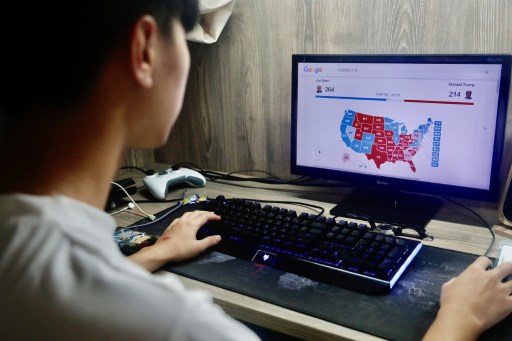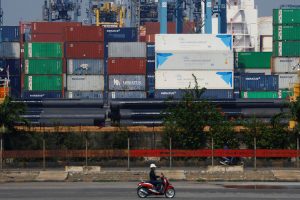(ATF) Taiwan, a global hub for high-tech hardware manufacturing, has already become a refuge from the Sino-US trade dispute and a new place for Chinese buyers to source semiconductors as Beijing and Washington spar over access to US technology.
Now China is giving Taiwanese tech firms another boost as they shun made-in-America: a run on orders for display panels to make smartphones, notebook PCs and television sets.
In October, companies in China placed 68.5% of the $2.27 billion in total orders for a Taiwan export category headlined by displays, Taiwanese government data show. China’s orders for the month went up 15.8% compared to October a year ago so they could manufacture devices for telework worldwide.
Chinese electronics builders had been ordering from Taiwan for years and gotten their parts as well from Samsung Display and BOE, which is based in Beijing. Chinese smart-phone giants and Taiwanese manufacturers with China factories are among the takers.
Government data show that display panel orders to Taiwan began expanding in April to a peak in September when Chinese firms placed $300 million more than in the same month a year earlier. The October year-on-year change was $212 million.
‘Less reliance on US’
The growth in invoices to Taiwan shows that Chinese electronics makers aim to rely less on US supplies as trade disputes drag on, many analysts believe. That shift gives another advantage to the tech-intensive Taiwanese economy that’s expected to grow 1.56% this year while most of the world’s GDP slumps because of Covid-19 containment measures.
“Chinese tech firms face a shortage of these supplies, which they need to make displays for consumer electronics,” said Tracy Tsai, Taipei-based research vice president with the market analysis firm Gartner. “But they don’t feel so good anymore about sourcing them from US companies given all the trade and tech wars of late.”
Display supplies are running short worldwide as producers raise output for notebook PCs that are in heavy global demand for telework and online schooling, Taipei-based market research firm TrendForce says. Chinese consumers make up a hefty share of the world market too.
Tech firms in China are sourcing other displays to make computer-aided vision cameras that detect face-masks and analyse the profiles of customers at banks, Tsai added.
Display panels ‘more competitive’
Taiwanese suppliers do a better job making displays than counterparts in China, said David Chen, a senior industry analyst with Taipei-based Market Intelligence and Consulting Institute. “With higher technical specs, Taiwan-made notebook PC panels are more competitive than China-made ones,” he said.
Some US-owned intellectual property and equipment can can no longer be shipped to China vendors, Tsai said. In particular, the US government’s squeeze on the flagship Chinese telecom firm Huawei Technologies this year prompted China to source an extra-large load of Taiwanese semiconductors in the third quarter. Huawei is China’s bestselling smartphone brand too, meaning it will need displays to keep up production.
The US Department of Commerce last year put Huawei on a list of companies barred from doing business with any organisation in the United States and added 38 Huawei affiliates effective this past September. Washington considers the Chinese firm a national security threat. The Sino-US trade war, a separate process, has generate US tariffs on $550 billion worth of Chinese products shipped to the all-important American market.
China is determined to rely less on the United States for supplies or technology after its spats with the Trump government and on its way to a goal of becoming a world tech giant by 2030, analysts believe. Chinese news website Chinanews.com said had last year China was set to become a “world tech powerhouse” after “accelerated leapfrogging” since 2011.
Orders from China to Taiwan in October made up about $11.8 billion across all export categories, down 18% over September but up 10.7% over October last year. Total orders from abroad came to $51.6 billion in October this year.
In the third quarter, $27.2 billion of Taiwan’s $90 billion in exports had come from China, Bureau of Foreign Trade data show. Chinese importers bought more than one-third of the $32.9 billion in exports from the category that covers semiconductors over that period.
Courting Taiwanese suppliers
“Chinese device manufacturers and Chinese authorities are actively courting Taiwanese suppliers of components such as displays to diversify their supply chain beyond traditional Western-led suppliers,” said Neil Mawston, executive director of wireless practice with the British market research firm Strategy Analytics.
China’s shift in sourcing supplies from Taiwan stands to benefit listed display makers such as Innolux and AU Optronics, David Chen said. AU Optronics already runs factories in China including one that opened near Shanghai in 2016 with installed capacity of 25,000 pieces.
“For mainland China, we have quite a lot of end-user PC clients,” said Katie Chen, a company senior corporate communications specialist.
The Sino-US trade dispute has prompted AU Optronics to do more of its core jobs in Taiwan, Chen added. Exporters that operate in China, even if based elsewhere, are subject to US tariffs. Last year AU Optronics kicked off a NT$40.7 billion plan to expand R&D, patents and training in Taiwan.
By Ralph Jennings in Taipei
























